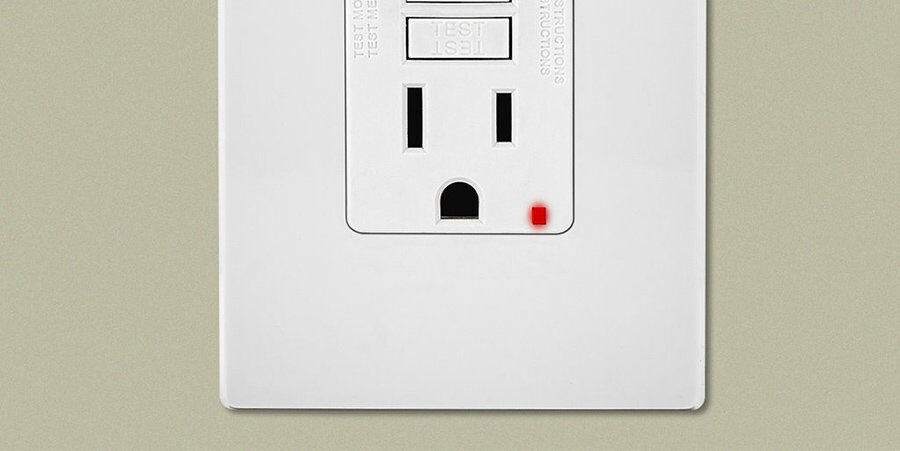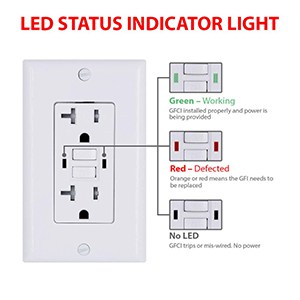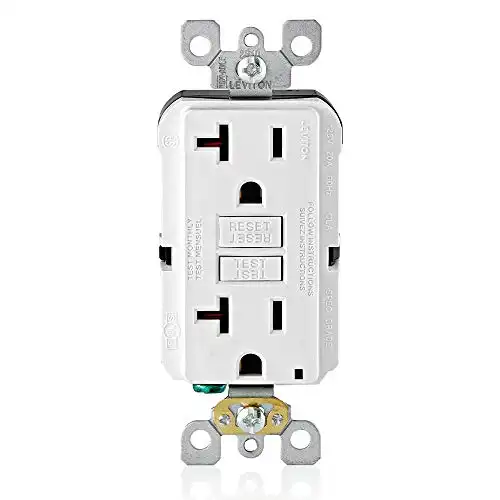Have you ever seen a GFCI outlet blinking red or yellow and wondered what was happening? If so, you’re not alone. Many people have never heard of a GFCI outlet before, let alone know what a blinking red light means.
The newer self-testing GFCIs have an auto-monitoring feature with an indicator light. The indicator light will be green when the outlet works correctly and passes the self-testing feature.
Self-testing GFCI outlets have built-in indicator lights. There is a problem when the GFCI outlet blinks red (or solid red). Self-testing GFCI outlets perform regular tests to make sure they work correctly. If the device fails the test, it will trip, and the red light will turn on.

Get FREE estimates from licensed electricians in your area today. Whether you need to replace an outlet, hang a ceiling fan, a new electrical panel, or repair wiring, We Can Help!
That would be a quick and easy answer. However, there is more to a GFCI outlet blinking red.
Here I will also go into a bit more detail. And provide you with a better understanding of how GFCIs function and what we need to do in the case of a GFCI blinking red light.
Why is My GFCI Outlet Blinking Red Light?

The newer GFCI receptacles (manufactured after 2015) require a self-monitoring system.
An auto-monitoring GFCI outlet will periodically test itself to ensure it works as intended.
You can generally find the light indicators on the GFCI outlets to be in three different states:
- A green light – If the green light is on, the outlet works as intended, providing the necessary protection.
- A red light – A red light means a problem with the device. Further investigation needs to be carried out.
- No lights – If neither red nor green light is flashing, no power is reaching the outlet, or the outlet may be tripped.
Self-Test Indications: A problem may exist if the Status Indicator Light is solid or flashing RED. Press the TEST button to trip the GFCI. If the outlet does not Reset, contact an electrician to replace the GFCI outlet.
The status indicator may momentarily flash red at power “ON” and Reset. If the light turns Green, the GFCI outlet is working correctly, so you don’t need to do anything else.
Think your GFCI outlets may be wearing out? Check out our article How Long Does a GFCI Outlet Last?
1. So, What Does a GFCI Outlet Blinking Red Light Mean?
A blinking red light will happen in the following scenarios:
- The red light on the GFCI outlet may be blinking during the first self-test it makes after being powered up for the first time.
- The red light will blink (or stay solid) if the GFCI outlet has been tripped.
- If the GFCI has failed its self-testing, it will lock up and prevent the electricity from flowing. In this case, it needs to be replaced with a new GFCI outlet.
2. What to Do If Your GFCI Outlet Blinks Red (Flashing Red Light)
A red light will signify a problem exists. In that case, the best thing that you can do is:
- Press the test button on the receptacle to trip the GFCI outlet manually.
- Then press the reset button.
If the outlet resets and restores the power to the circuit, and no red light is present, then this means that the receptacle is working correctly.
What to Do if the GFCI Outlet Doesn’t Reset?
If the outlet doesn’t reset and the GFCI outlet blinking red light continues to illuminate, the outlet is not working correctly and needs replacement. Before purchasing a new GFCI outlet, you must verify if you need a 15A or 20A-rated outlet. Check the back of the old GFCI to get the rating. Most will need a 20A GFCI outlet.
3. What May Cause a GFCI Blinking Red Light?
A GFCI outlet blinking red light may signify that the breaker has tripped.
In this case, we must consider what situations will cause a GFCI outlet to trip.
- Ground fault – If the outlet registers a ground fault, it will automatically trip. A ground fault can happen due to bad wiring, worn-out or frayed insulation, moisture and water, and more.
- Bad wiring – Bad wiring may also cause the outlet to trip. In this case, even replacing the outlet will not make any difference, and the electrical circuit needs to be inspected.
- Circuit overload – If an electrical circuit gets overloaded, the GFCI will most likely trip to prevent overheating. This can happen because too many electrical appliances are plugged in on the same circuit. Also, faulty electrical equipment can cause that too.
- Worn-out GFCI outlet – Like everything else, GFCI outlets can go bad with time. Usually, they are expected to work as intended for at least 25 years. However, due to natural wear and tear and other conditions, you may severely reduce this time, and they may fail way earlier.
- Another tripped GFCI in the same circuit or a ground fault in an electrical circuit that is in very close proximity.
One more detail to remember – especially if you have just replaced an old working outlet with a new GFCI outlet blinking red – is likely indicates the problem is elsewhere on the electrical circuit, like another receptacle on the same circuit.
What Is a GFCI Outlet?
A Ground Fault Circuit Interrupter (or GFCI) is an electrical outlet or breaker. GFCIs can be considered a type of breaker.
The primary purpose of the GFCI outlet is to protect us from electrical shocks that can happen from ground faults. Usually, this may occur when an electrical appliance or tool malfunctions.
When the GFCI registers a ground fault, it will immediately cut out the power to the corresponding outlet — thus protecting us from receiving an electrical shock.
You still may feel a tiny electrical shock, but it will be far from dangerous.
So what is a ground fault?
A ground fault means that the electricity is not following its predesignated path. Electricity is always trying to find the quickest path to the earth. And in the case of a ground fault, this usually means that the electricity has found a different path to reach the earth, and frequently this path can be our body.
The GFCI also protects the electrical circuits from overheating during an electrical fault. That way, it provides increased protection against electrical fires.
1. How Does a GFCI Work?
GFCI outlets work by constantly monitoring the electrical circuit they are installed on. They will keep track of the amount of electrical current that goes in (to the electrical appliance or tool used) and compare it to the electrical current that goes out.
The GFCI outlet will consider this a potential hazard if there is a significant current loss. And will immediately cut out the power to the outlet.
GFCI outlets can detect imbalances of the electrical current that are as small as 0.005 amperage and can cut out the power in as little as 1/40th of a second.
2. Are GFCI Outlets Necessary?
GFCI outlets and circuits are mandatory in the National Electrical Code to prevent electrical shock.
The standard breakers in the electrical panels are usually adapted to cut out the power to the corresponding circuits at 10 – 20 amps amperage. However, exposing ourselves to a mere 0.1 amps for two seconds might be fatal.
GFCI outlets are a necessary safety feature to provide ourselves and our families with the risk of electrical shock.
3. Where You Need to Have GFCIs Installed
GFCI has to be installed on all 120 volts, 15 to 20 amperage receptacles in our home.
NEC requires GFCIs in kitchens, bathrooms, laundry areas, whirlpool tubs, and any receptacles in outdoor areas, porches, balconies, unfinished basements, garages, crawl spaces, etc.
Every receptacle within 6 feet from the edge of any sink, shower, or bathtub needs to be GFCI protected.
If you have questions about GFCI code requirements, see our article Common Questions About GFCI Code Requirements.
4. How to Recognize a GFCI Outlet?
GFCI outlets have two buttons (a Test and Reset labeled buttons), usually located in the middle of the receptacle.
Finally, on GFCI outlets installed on ungrounded wiring, you need to label it as “No Equipment Ground.” You can’t test an ungrounded GFCI with a GFCI outlet tester. However, you can test it with the built-in Test button.
Get FREE estimates from licensed electricians in your area today. Whether you need to replace an outlet, hang a ceiling fan, a new electrical panel, or repair wiring, We Can Help!
Conclusion
A GFCI outlet red light blinking can be very annoying, but it’s a safety feature that could save your life. You should contact an electrician to troubleshoot why a GFCI outlet blinks red because it could be as simple as replacing the outlet, or it can indicate a more serious issue is present.









